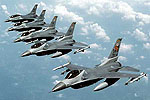U.S., Korean air forces rumble forward in Max Thunder 11-1
 KWANGJU AIR BASE, Republic of Korea (AFNS) -- The South Korean and U.S. air forces hosted a joint exercise here May recently to sharpen their ability to work together in a simulated wartime environment.
KWANGJU AIR BASE, Republic of Korea (AFNS) -- The South Korean and U.S. air forces hosted a joint exercise here May recently to sharpen their ability to work together in a simulated wartime environment.
The exercise, held annually, provided bilateral training to more than 320 personnel from the 8th Fighter Wing at Kunsan Air Base and the 51st Fighter Wing and 7th Air Force at Osan Air Base. It is the largest on the Korean peninsula.
"Max Thunder is the only exercise we have on the peninsula that allows for both (Korean) and U.S. airmen to not only fly together, but plan, brief and debrief together," said Maj. Bill Maclin, the 7th Air Force chief of training. "This really allows the alliance to grow stronger to enhance all of our operational capabilities as well as enhance the interoperability and communication among our air forces."
"Over the last few years, the U.S. has really gotten used to hosting large force exercises like Red Flag," said Maj. T.J. Lowe, 36th Fighter Squadron assistant director of operations at Osan AB. "Max Thunder allows ROKAF the experience in hosting international exercises."
"They can see how the U.S. operates on a much bigger scale," Major Lowe said. "It enhances our ability if we ever have to go north."
Members of the Royal Australian Air Force attended to observe operations between the Koreans and Americans.
"We were invited to take a look at this world-class exercise hosted by the ROKAF," said Sq. Ldr. Anthony D'Alessandro, the HQ RAAF Air Command exercise planning officer. "It's excellent to see the exceptional interactions and high caliber of professionalism between the Air Force and ROKAF. It's clear the process is similar to what we use back home."
"Our mission here is to help them understand how to accept follow on forces," said Master Sgt. Jerry Thomas, the 8th Aircraft Maintenance Squadron night shift production supervisor. "This gives them the best equipment and training to help them succeed. Though our mission is the same as back home -- to make sure jets are ready to launch at a moment's notice."
Working alongside their Kunsan brothers and sisters, Airmen from Osan AB assigned to the 621st Air Control Squadron said the exercise meant greater communication of operational capabilities and helped facilitate professional development and growth.
"I think it's a great opportunity for ROKAF and Air Force personnel to practice exactly what we would do in case of a real world threat," said Tech. Sgt. Michael Harris, the 621st ACS weapons director at Osan AB. "If we don't practice together now it would be more difficult if a real world event were to happen."